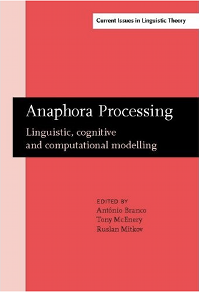 We examine demonstrative pronouns in a portion of the Santa Barbara Corpus of American English and propose a coding scheme that classifies pronouns with nominal as well as non-nominal antecedents into direct and indirect, depending on whether their referent is the same as the referent/denotation of the antecedent. In agreement with previous studies, we find that demonstratives more often have non-NP antecedents than NP-antecedents, the opposite pattern from that of the personal pronouns. Since anaphoric relationships involving non=NP antecedents are more frequently indirect, our scheme allows for a principled explanation for the difference in distribution patterns of demonstratives compared with personal pronouns. We propose that the indirect anaphoric cases are more accessible to reference with demonstratives because, demonstratives only require the referent to be activated, not necessarily in focus.
We examine demonstrative pronouns in a portion of the Santa Barbara Corpus of American English and propose a coding scheme that classifies pronouns with nominal as well as non-nominal antecedents into direct and indirect, depending on whether their referent is the same as the referent/denotation of the antecedent. In agreement with previous studies, we find that demonstratives more often have non-NP antecedents than NP-antecedents, the opposite pattern from that of the personal pronouns. Since anaphoric relationships involving non=NP antecedents are more frequently indirect, our scheme allows for a principled explanation for the difference in distribution patterns of demonstratives compared with personal pronouns. We propose that the indirect anaphoric cases are more accessible to reference with demonstratives because, demonstratives only require the referent to be activated, not necessarily in focus.
Gundel, Jeanette, Nancy Hedberg, and Ron Zacharski. 2005. Demonstrative pronouns in natural discourse. Anaphora Processing: Linguistic, Cognitive and Computational Modeling, ed. by Antonio Branco, Tony McEnery, and Ruslan Mitkov. John Benjamins, 351-364. (pdf)